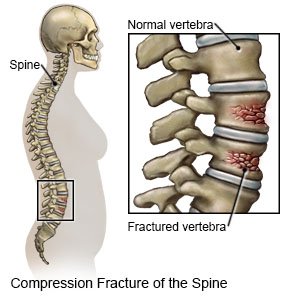Vertebral Compression Fracture
Medically reviewed by Drugs.com. Last updated on Aug 4, 2025.
A vertebral compression fracture (VCF) is a collapse or breakdown in a bone in your spine. Compression fractures happen when there is too much pressure on the vertebra. VCFs most often occur in the thoracic (middle) and lumbar (lower) areas of your spine. Fractures may be mild to severe.
 |
WHILE YOU ARE HERE:
Informed consent
is a legal document that explains the tests, treatments, or procedures that you may need. Informed consent means you understand what will be done and can make decisions about what you want. You give your permission when you sign the consent form. You can have someone sign this form for you if you are not able to sign it. You have the right to understand your medical care in words you know. Before you sign the consent form, understand the risks and benefits of what will be done. Make sure all your questions are answered.
Medicines:
- NSAIDs help decrease swelling and pain.
- Acetaminophen decreases pain.
- Prescription pain medicine may be given. Do not wait until the pain is severe before you ask for more medicine.
- Bisphosphonates and calcitonin may be recommended to help your bones get stronger. They can decrease the pain of a VCF caused by osteoporosis, and decrease your risk for another fracture.
Related medications
Tests:
- X-rays, a CT scan, or MRI of your spine may be taken. You may be given a dye before the pictures are taken to help healthcare providers see the pictures better. Tell the healthcare provider if you have ever had an allergic reaction to contrast dye. You should not enter the MRI room with anything metal. Metal can cause serious injury. Tell the healthcare provider if you have any metal in or on your body.
- A bone scan of your spine may be done. The pictures may show broken bones or other problems in the spine, such as an infection.
Treatment:
- Surgery may be needed if your pain, weakness, or numbness does not go away after other treatments. Surgery may make your spine more stable, and help decrease pressure on your spinal nerves caused by the fracture.
- Vertebroplasty is a procedure that is used to place bone cement into the fractured vertebrae.
- Kyphoplasty is a procedure that uses a balloon to make a space in the fractured vertebrae. Bone cement is then put inside the space made by the balloon.
- Open surgery returns bones to the right place and holds them together with wires, pins, plates, or screws.
- Physical or occupational therapy may be started while you are in the hospital and continued after you are discharged. A physical therapist teaches you exercises to help improve movement and strength, and to decrease pain. An occupational therapist teaches you skills to help with your daily activities.
RISKS:
Even with treatment, signs and symptoms of a VCF may come back. You may develop a life-threatening blood clot if you are on bed rest or not able to move easily.
CARE AGREEMENT:
You have the right to help plan your care. Learn about your health condition and how it may be treated. Discuss treatment options with your healthcare providers to decide what care you want to receive. You always have the right to refuse treatment.© Copyright Merative 2025 Information is for End User's use only and may not be sold, redistributed or otherwise used for commercial purposes.
The above information is an educational aid only. It is not intended as medical advice for individual conditions or treatments. Talk to your doctor, nurse or pharmacist before following any medical regimen to see if it is safe and effective for you.
Learn more about Vertebral Compression Fracture
Treatment options
Care guides
Symptoms and treatments
Medicine.com guides (external)
Further information
Always consult your healthcare provider to ensure the information displayed on this page applies to your personal circumstances.
